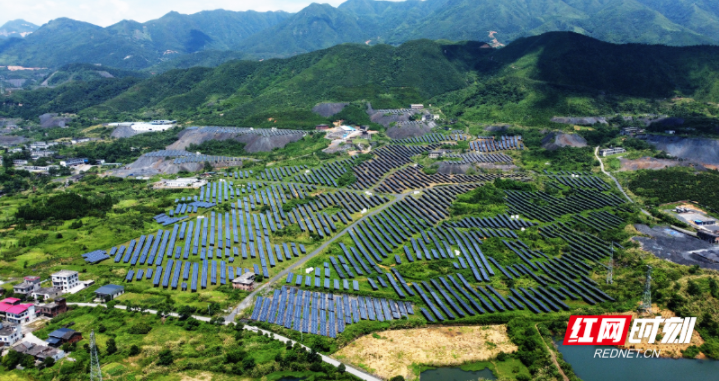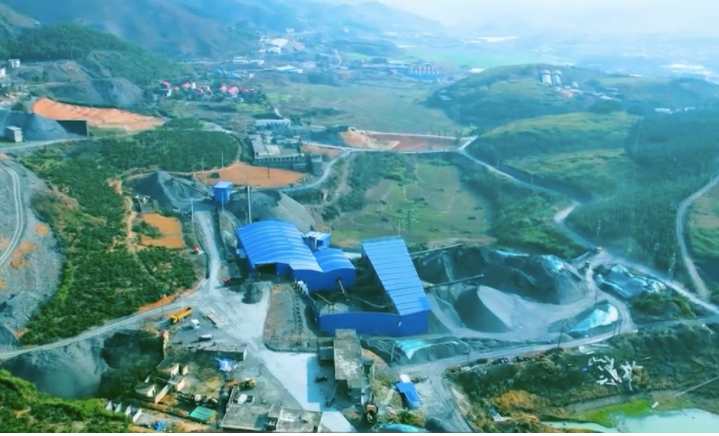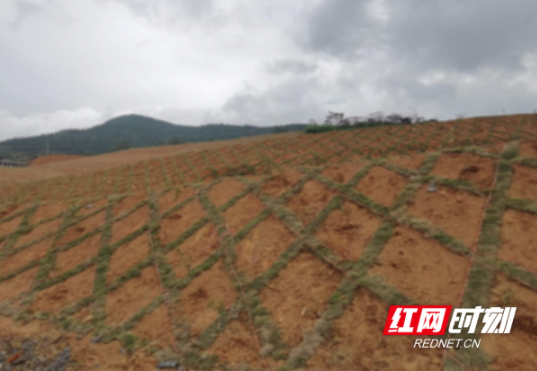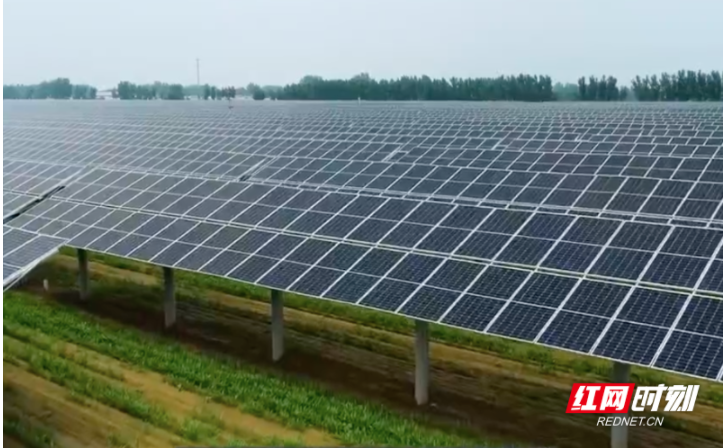Guiyang County restores mining areas by solar power
2024-06-25
Rows of photovoltaic panels are installed on the barren mountains of the Heye-Taiqing mining area in Guiyang County, shining brightly under the sunlight. They continuously convert solar energy into electricity, which is transmitted to modern agricultural and animal husbandry enterprises in the surrounding area to develop new energy, agricultural planting, and animal husbandry.

The mining area has a long history of mining, and small coal mines are scattered everywhere. After years of disorderly mining, the ecological environment has been severely damaged, and the mines left over by history have occupied large land resources.
To solve this series of prominent problems, Guiyang County has explored a new path through ecological governance to revitalize abandoned mines. It has been included in the top ten examples selected from the second ecological restoration of national land space in Hunan.
Enterprises introduced to develop abandoned mines
Many years ago, the mining area was covered with a large amount of abandoned coal gangue. Coal gangue is the associated rock of coal and the waste generated during the development, mining, and coal washing processes of coal mines. Not only does it take heavy toll on the environment, but it also poses a huge threat to the safety of local people’s lives and property, as it is prone to geological disasters such as mudslides.

Therefore, Guiyang County has introduced enterprises such as Hunan Construction Engineering Group and Hunan Qixing Construction Engineering Co., Ltd. to sort, process and sell abandoned coal gangue according to its composition, and the profits obtained can be used in turn as funds for ecological restoration of mines.
There are 104 large and small coal gangue piles in the mining area, of which about 5 million cubic meters of coal gangue can be utilized. As of now, more than 40 million yuan has been invested to build a fully automatic coal gangue processing production line, with a maximum processing capacity of 800 tons/hour. It can be used to process and manufacture products such as crushed stones, machine sand, and tailings.
“We can obtain ceramic tiles and various building materials by processing these products, and then sell them to the Guangdong-Hong Kong-Macao Greater Bay Area and Changsha-Zhuzhou-Xiangtan regions,” said Wang Shengzhuo, head of Hunan Qixing Construction Engineering Co., Ltd.
Various measures taken to restore damaged land
After the comprehensive utilization and cleaning of coal gangue, according to the national spatial planning and relevant industrial planning, restoration projects are deployed according to local conditions to repair damaged farmland in the mining area, and restore vegetation and land functions.
Guiyang County has planted oil tea trees on a large scale in areas with suitable soil and water conditions based on the will of local people. Their initiative and responsibility will ensure the smooth progress of the project construction and long-term sustainable benefits after the project is put into operation.

At the same time, a turf-style diamond grid slope protection measure has been adopted, and oil-tea trees have been planted in the middle of the grid to restore the shrub layer, so as to form an overall shrub grass community on the slope surface. This can quickly control soil and water loss on the slope, compensating for the insufficient ecological protection effect of trees and shrubs in the early stage of restoration, and provide essential soil and water conditions for the rapid growth of oil-tea camellias on the slope.
Through comprehensive management and systematic restoration, 1,000 mu (about 66.67 hectares) of forest land and over 90 mu (6 hectares) of arable land have been restored in the mining area, greatly alleviating the land use contradiction, enhancing the regional water source conservation and soil and water conservation capabilities, and improving the ecological environment.
These are all vivid practices of Guiyang County in implementing ecological restoration in mining areas.
Photovoltaic industry developed to utilize land resources
According to statistics, Heye Town has developed 600 mu (40 hectares) of photovoltaic panels, which can generate over 20 million kilowatt hours of electricity annually, increase the collective economy of the village by 180,000 yuan, save 7,544 tons of standard coal, and reduce carbon dioxide emissions by 18,803 tons.
The once abandoned mines have been dedicated to local economic and social construction.

Through the “photovoltaic plus” model, Guiyang County has developed the photovoltaic industry according to local conditions on the restored mines, and planted crops such as polygonatum odoratum under the photovoltaic panels or reclaimed grasslands to develop animal husbandry, which has a strong demonstration effect on the market-oriented ecological restoration of mines in the province and the green and low-carbon development.
The integration of photovoltaic development and ecological restoration of mining areas can not only generate clean electricity, but also help stabilize soil, reduce water evaporation, and turn wasteland into green space.
“The environment is very good now. There used to be a lot of dust, but now the air is fresh,” said a villager from Gantang Village in Heye Town.
The market-oriented restoration practice in the Heye-Taiqing mining area has brought about a brilliant green transformation in Guiyang.




